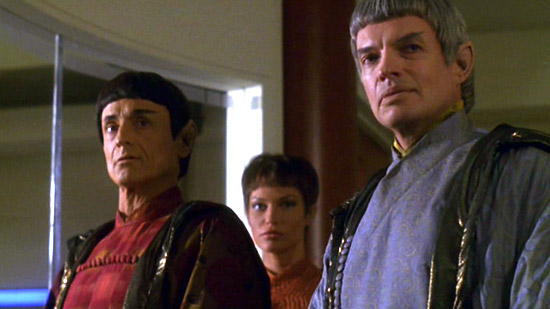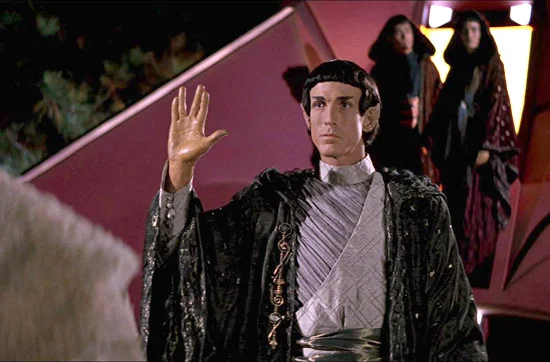An audio version of this Captain’s Log is available.
by Christopher Jones
The fictional universe of Star Trek represents one possible future. That future has been assembled by numerous writers over the course of 45 years, six television series, and eleven feature films. When dealing with such a long span of time, so many contributors, and the evolving nature of society, it’s only natural that elements of this universe will change, stories will contradict one another, and early ambiguities will be filled in by later treks. Yet there is a prevailing feeling that every subsequent incarnation of Star Trek must adhere to its predecessors without fail. And when it doesn’t, the deviation can set off a firestorm within fandom. Let’s take a closer look at the fine line that writers walk and at some of the moments that have been labeled “rewriting Trek.”
You Put Your Chocolate In My Peanut Butter
Way back in 2000, before we really knew what the fifth live-action Star Trek series would be about, I pointed out the dangers of writing a show set between TOS and TNG. At the time there was a petition drive underway on the Internet aimed at pressuring Paramount to base the new series on the voyages of the Excelsior under the command of George Takei’s Hikaru Sulu. Plopping a new series right in the middle of established Trek history would have placed the writers in a minefield of potential contradictions that would have no doubt sent fans into a letter-writing fury.
Many fans wanted to see a weekly Sulu series.
When it was announced that the new series—Enterprise—would take place before established Trek history, I praised it as a stroke of genius. The move offered creative freedom in a time period that was hardly touched by prior Trek canon. It’s hard to contradict what has yet to be written.
Oh the naivety. Sure, it might be difficult to contradict something that technically does not yet exist, but when fans expect you to set up what is to come there are still many pitfalls.
Alien Encounters
The first potential “rewriting Trek” pitfall centered around the Vulcans, which fans felt were not portrayed accurately in Enterprise because they weren’t like the Vulcans of the TOS and TNG eras. Since the entire foundation of the series was based upon the relationship between Earth and Vulcan in the century following the events of First Contact, there was no way to avoid rewriting Vulcan history. Though to be fair, it wasn’t rewriting; it was merely filling in. We really never learned all that much about the Vulcans from the series that had come before, and for them to work on Enterprise they would have to be fleshed out. Yes, the Vulcans of Enterprise were more emotional, more deceptive than those of the TOS and TNG eras, but is that rewriting Trek? No. These were Vulcans of an earlier time period and just as our society evolves so should theirs. The fact that there weren’t simply a bunch of Spocks and Tuvoks running around added depth to Star Trek. It was the right way, creatively, to approach them.
The Vulcans of Enterprise weren’t exactly what fans were expecting.
Beyond the Vulcans, the writers dipped into TOS lore for the first time in the sixth episode of the series, “The Andorian Incident.” Another of Star Trek’s most famous races, the Andorians, had virtually no history to contradict. We knew they were a founding member of the Federation but otherwise only tidbits had been dropped here and there in other series, such as the fact that Andorian weddings require four people (TNG; “Data’s Day”) or that Andor was the Dominion’s next target after Betazed (DS9; “In the Pale Moonlight”). This was rather safe territory.
Handling the Klingons would also be a challenge for the Enterprise writers. Following their role in the series pilot, “Broken Bow,” the Klingons next appeared more than halfway through the first season in “Sleeping Dogs.” Unlike the major revisions (or fleshing-out) of the Vulcans, the Klingons of the 22nd century remain remarkable similar to those we came to know in TNG and DS9. You could hear the collective exhaling of relieved fans.
That exhalation was quickly followed by a gasp, however, as the writers threw caution to the wind and brought the Ferengi to Enterprise in the episode “Acquisition.” This was a ballsy move and one not well received by fans. The Ferengi were only referred to as thieves and never named, but this is an example of what many consider rewriting Trek. There’s no reason that the crew of the NX-01 encountering rogue Ferengi violates canon, but feelings run deep in Star Trek fandom and this was a slap in the face to many.
George de Mestral Did Not Invent Velcro
The next big rewriting-Trek moment came early in season two with the episode “Carbon Creek.” Many fans felt that Berman and Braga had fallen into a major hole. Case in point: Entertainment Weekly, whose “What to Watch” column for September 25, 2002, said that the episode somewhat diluted the significance of the events in the film First Contact. But is this true?
First Contact provided the official story of how humans and Vulcans met.
Not really. “Carbon Creek” was great storytelling that left us wondering without really changing anything. It certainly all seemed plausible as T’Pol’s tale unfolded, but when asked at the end if it really happened, she wouldn’t commit either way, only saying “you asked me to tell you a story.”
And really, isn’t that what we all have asked the Star Trek writers over the years? Tell us a story. “Carbon Creek,” to me, is case in point that fans must not lose sight of the fact that writers are creatives and without freedom to explore creativity dies. Canon is a wonderful thing and keeping all of the details of a created universe consistent is what makes it so real. We feel as if we live in Star Trek’s future. But when we ask writers to tell us a story, we must allow a certain amount of flexibility.
First Contact is one account of how humans and Vulcans first met, but it wasn’t the only one even prior to “Carbon Creek.” There was a popular novel called Strangers from the Sky, written by Margaret Wander Bonanno in 1987, in which Vulcans crash land in the South Pacific. I read this novel long before the film First Contact was ever conceived. For me, this is how humans and Vulcans first met. The film contradicted that. But because First Contact was a movie instead of a novel it became the accepted history of Star Trek.
When Enterprise rolled around these events were rewritten once again, at least for the sake of T’Pol entertaining Archer and Trip. Whether or not Vulcans crashed in Pennsylvania in 1957 remains unclear. When T’Pol returns to her quarters she pulls out a bag that appears to be the one that her great grandmother, T’Mir, carried on Earth in the story. It certainly appears as if the story was true, but we can’t be sure.
This is not rewriting Trek. In fact, if anything, this makes the Star Trek universe more real. How many events have taken place in our own past that have been lost to history? We like to think in the 21st century that we know how our history truly unfolded. We “know,” for example, that a comet impact killed the dinosaurs, that written language was born in ancient Egypt, that Columbus discovered America, that Neil Armstrong was the first person to set foot on the moon, and that George de Mestral invented Velcro.
I can hear your alarms going off right now. At least one of those is not correct. And that’s the point: we can’t really know with complete certainty what happened in the past because history is rife with inaccuracies and uncertainties, some caused by history being written by the victors and some caused by insufficient information.
During the same month that “Carbon Creek” first aired, researchers at Vanderbilt University announced the discovery of steps in Guatemala on which detailed accounts of a great war—an ancient “world war”—are recorded. As it turns out, this war helped bring about the collapse of Mayan civilization and contradicts previous theories on the subject. We thought we knew what happened, but then new information came to light.
We Need Breathing Room
One of the most appealing aspects of Star Trek is the atmosphere of reality—or at least plausibility—that it creates for the viewer. Given our current rate of technological and scientific advancement, it is not difficult to believe that our world in the 22nd, 23rd, and 24th centuries may be similar to that portrayed in Star Trek. Tossing in the idea that, perhaps, the Federation’s account of history is inaccurate only serves to strengthen the reality of Star Trek, though doing so is always a risky endeavor when it comes to this franchise.
Humorous yet serious, “Carbon Creek” was one of Enterprise’s early gems. Berman, Braga, and Dan O’Shannon managed to bring a new twist to the Star Trek timeline without actually rewriting it. There were some hilarious moments mixed in with the mostly serious social commentary on the qualities and potential of humanity. Perhaps the funniest moment was when T’Mir pulled a piece of Velcro out of her purse—“the invention that is going to change the world.” The buildup made it so certain that it would be some Vulcan techno gadget that the ripping sound of Velcro had to bring a smile to the face of most any viewer. And maintaining the idea that Vulcans cannot tell a lie, T’Mir explained to a bar patron that they were in Carbon Creek because “we had an accident with our vehicle outside your town.” (Of course, this idea was torn down at the end when she tells the other Vulcans that Mestral died in the crash.)
Mankind’s first face-to-face encounter with aliens was with Ferengi, not Vulcans.
Supposing that the crash did happen and Vulcans were on Earth interacting with humans in the 1950s, does it rewrite the events of First Contact? I say no. If you want to get right down to it, first contact as established in the Trek canon occurred in 1947 when Quark, Rom, Nog, and Odo crashed in Roswell, New Mexico, in the DS9 episode “Little Green Men.” (You could further argue that it occurred in “The City On the Edge of Forever” when Edith Keeler met Spock; but she did not know that he was an alien.) As presented by canon Mankind’s first face-to-face encounter with aliens was with Ferengi, not Vulcans. But what really counts is the first initiated, formal contact, which is still what we saw in the film account of Zefram Cochrane’s warp flight.
After “Carbon Creek” Enterprise ran its course and encountered Romulans, Borg, Tellarites, and many more familiar faces from Star Trek’s “past.” By then most fans had tuned out and what could have been the biggest rewriting-Trek minefield of all—Enterprise’s fourth season—passed without fanfare. And then the franchise went silent…
…until an even grander rewriting experiment began.
Next time we’ll look at the J.J. Abrams reboot of Star Trek and how this rewriting of Trek has gone where even Enterprise dared not tread.






